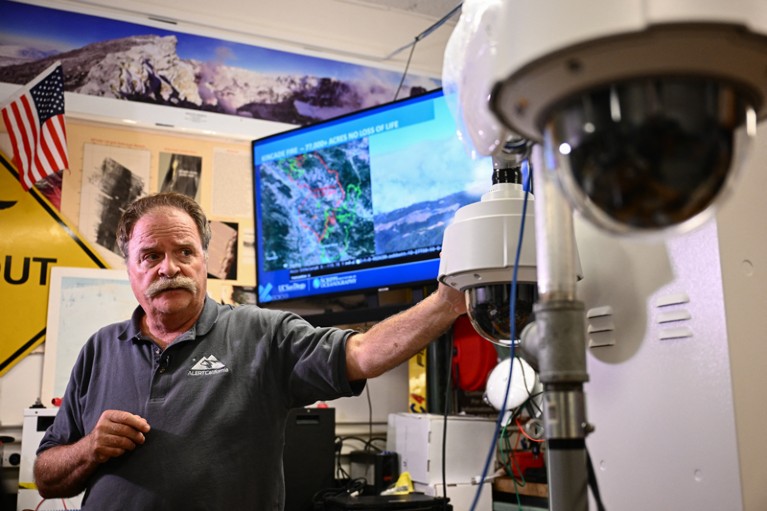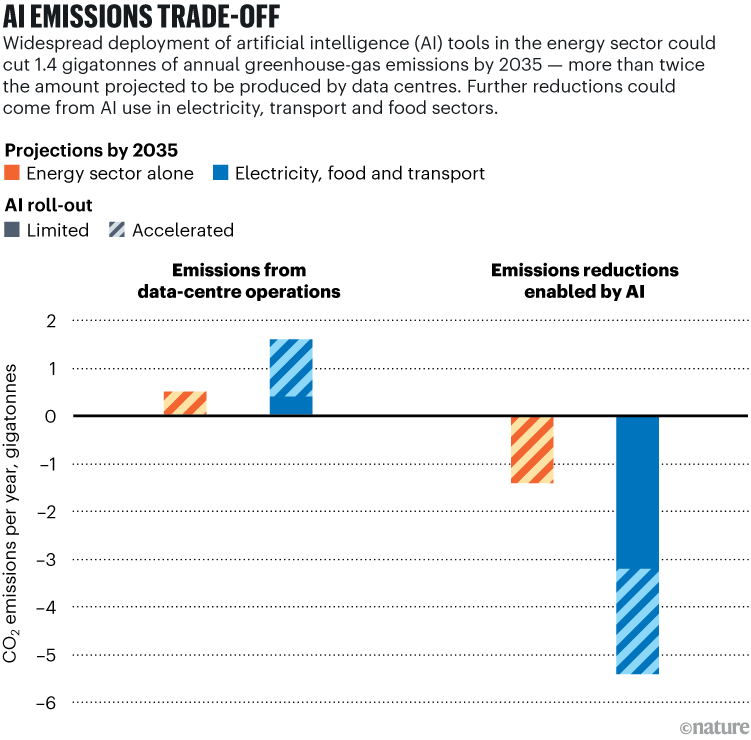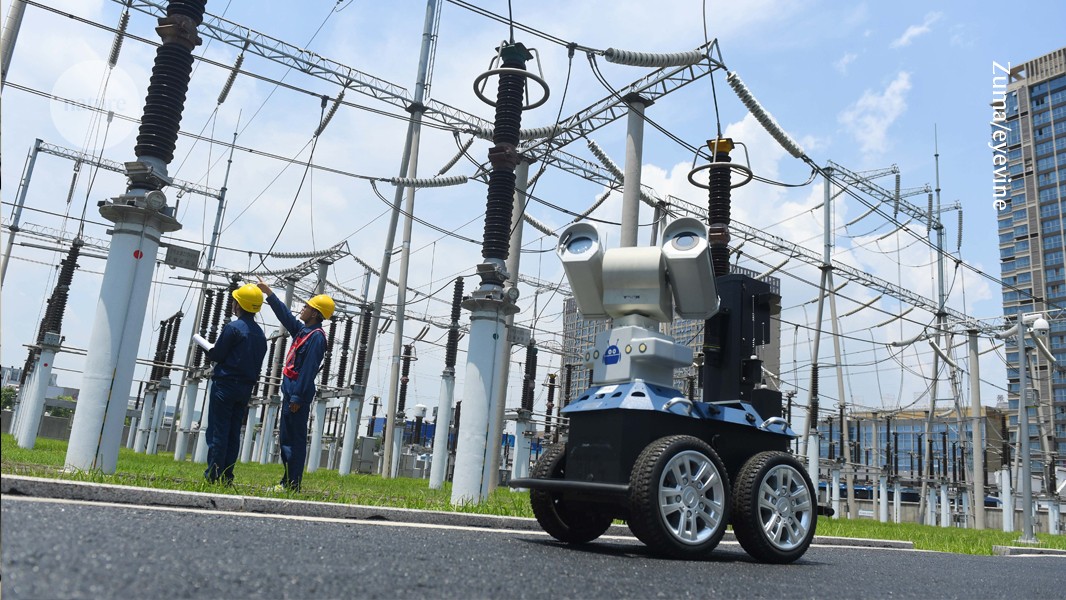In 2024, the global average annual temperature exceeded 1.5 °C above pre-industrial levels for the first time. Greenhouse-gas emissions are rising, and the window to reach net zero by 2050 is closing fast.
Artificial intelligence (AI) systems can play a crucial part by improving energy and resource-use efficiency, accelerating innovation and expanding people’s capacity to act. But without swift, deliberate effort, this opportunity could slip away.
Realizing net zero — balancing the amount of carbon emissions emitted with the amount removed — by mid-century will require rapid, large-scale transformations. Electricity generation must nearly double by 2050 as transport, heating systems and industries shift from fossil fuels to electric power. Renewable-energy capacity must triple by the end of this decade to meet the rising demand without simultaneously increasing emissions1.
Six roadblocks to net zero — and how to get around them
Steel, cement, chemical and other industries — which are responsible for almost one-third of global carbon-dioxide emissions — must shift to near-zero emissions, even though affordable, scalable alternatives are limited1. Carbon removal must increase rapidly. Highly durable removal methods such as enhanced rock weathering — which can store CO2 for centuries to millennia — must scale up by a thousandfold by 2050, removing gigatonnes of CO2 annually to help neutralize the hardest-to-abate emissions2. Progress is constrained by three barriers: system complexity, slow innovation and workforce gaps. For example, electricity grids can become harder to manage as reliance on variable, decentralized renewable sources rises. Clean technology can also take years to develop and scale up, and skilled workers are in short supply.
AI is not a silver bullet — but without it, these problems are unlikely to be solved fast enough. Much attention has focused on AI’s high energy consumption and water use. These operational impacts can strain local power grids or exacerbate water stress, and must be actively addressed. But they are not major drivers of global climate change. Framing them as such distracts focus from AI’s transformative climate-mitigation potential and from its biggest influence on the climate, which will depend on how it is used.
Here, I put AI’s operational footprint in the context of its broader climate impact and outline five areas of action that are needed to realize the technology’s potential to achieve deep decarbonization.
AI’s climate ledger
AI’s demand for electricity is rapidly increasing. The International Energy Agency (IEA) reports that global electricity use by data centres could more than double by 2030, reaching about 3% of global electricity consumption, with AI-dedicated servers driving nearly half of the growth3. In the United States, data centres consume about 4.4% of electricity and could reach 6.7–12% by 2028, depending on AI deployment and efficiency4.
Meeting this surge entirely with carbon-free power is challenging. In the past, data-centre developers only prioritized cost and infrastructure. Now, many also consider grid capacity and carbon emissions. But transmission bottlenecks and permit delays are slowing carbon-free electricity growth, making it hard to keep up with AI-driven demand.
Light bulbs have energy ratings — so why can’t AI chatbots?
Some regions are turning to natural gas to meet rising demand. In central Ohio, regulators approved the development of new gas plants for incoming data centres. In northern Virginia, analysts estimated 10–15 gigawatts of natural-gas capacity could be needed to meet data-centre demand (see go.nature.com/45zdgna).
But, from a global perspective, AI’s operational footprint remains modest. Data centres use about 1.5% of global electricity and contribute roughly 0.5% of total CO2 emissions3. Water use for data-centre cooling and electricity supply is about 560 million cubic metres annually, less than 0.08% of global freshwater consumption3,5. By 2030, data-centre water consumption is expected to more than double3. Although that is a modest amount on a global scale, data-centre resource demand can add stress to local grid and water systems.
A widely cited claim — the chatbot ChatGPT needs to ‘drink’ a 500-millilitre bottle of water for a simple conversation — sounds alarming but is misleading. Analysis shows that 87% of that water is used to cool power plants6. This highlights a little-known fact: electricity generation still uses mainly fossil fuels and is extremely water intensive. Every time you turn on a light, water is consumed.
ChatGPT’s 2.5 billion daily queries consume about 0.5% of the amount of electricity used each day by people watching television in the United States. The chatbot’s estimated daily water consumption — about 3,700 m3 — is negligible relative to the 690,000 m3 used for powering US televisions, and the roughly 43,000,000 m3 of water lost daily in the United States owing to leaky pipes (see Supplementary Information).

A system that uses AI technology and more than 1,000 cameras detects wildfires in California.Credit: Patrick T. Fallon/AFP/Getty
AI’s biggest climate consequences will come from how it is used. It could increase emissions by boosting fossil-fuel extraction. Without adequate governance safeguards, AI systems could also undermine climate progress by deepening inequalities and eroding trust7.
But the technology can also serve as a pivotal tool to cut emissions by overcoming barriers of complexity, speed and scale. For example, AI-enabled dynamic line ratings (a technology used to monitor the real-time capacity of overhead power transmission lines) use real-time data — such as temperature, wind speed and other weather conditions — to continually adjust the safe operating capacity of power lines. This can increase transmission capacity by up to 40%, allowing more power from wind and solar technologies to flow through existing grids and reducing the need for costly and time-consuming building of new infrastructure (see go.nature.com/428hqx7).
Why coalitions of wealthy nations should fund others to decarbonize
AI is also accelerating the search for low-carbon materials, including alternatives to cement. Cement production is one of the largest single industrial sources of CO2 emissions, mainly because of clinker — the key binding agent — the production of which releases large amounts of CO2 during limestone processing. Cutting these emissions requires replacing clinker with other materials that match its strength and durability. With conventional trial-and-error methods, this could take decades.
In May, researchers at the Massachusetts Institute of Technology (MIT) in Cambridge showed that AI could be used to speed up this process drastically. Their system scanned 88,000 scientific papers and analysed data on one million rock samples, rapidly narrowing down the field to 19 promising clinker substitutes — a task that Soroush Mahjoubi, the lead author and a civil engineer at MIT, said would have taken “many lifetimes” using conventional laboratory methods8. However, discovery is only the first step. Bringing such materials to market still involves rigorous performance testing, navigating regulatory approval and persuading a typically conservative construction industry to adopt new products at scale.
The IEA estimates that by 2035, widespread AI deployment in the energy sector could cut annual CO2 emissions by 1.4 gigatonnes — more than twice the amount projected from data-centre emissions (see ‘AI emissions trade-off’). These savings would come from smarter control and forecasting of demand, system conditions and emissions sources3. Economist Nicholas Stern and his colleagues at the London School of Economics and Political Science estimated even greater potential: 3.2–5.4 gigatonnes of annual reductions by 2035 across electricity, transport and food sectors9.

Sources: Energy, Ref.3.; Electricity, food and transport, Ref.9.
AI alone will not deliver net zero, but it is a powerful tool for accelerating deep, sustained decarbonization. Realizing its full potential requires doing the following.
Five actions
Invest in AI for the climate. In 2024, AI climate-technology raised US$6 billion, with most directed towards commercially attractive sectors such as autonomous vehicles and optimization in energy, homes and agriculture10. Crucial areas such as grid integration, materials discovery and carbon removal remain underfunded, despite AI’s potential to accelerate progress3.





